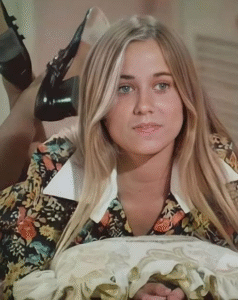The Brady Bunch: A Timeless Tale of Family, Fun, and Behind-the-Scenes Drama
Few television shows have achieved the enduring cultural impact of The Brady Bunch. Premiering on September 26, 1969, the show quickly became a symbol of wholesome family entertainment, introducing audiences to the blended Brady household—a dynamic family consisting of a widowed father, a widowed mother, and their six children. Over fifty years later, The Brady Bunch remains a touchstone in popular culture, celebrated for its humor, charm, and heart, while also fascinating fans with its lesser-known behind-the-scenes drama.
A Groundbreaking Premise
At a time when traditional family structures dominated television, The Brady Bunch presented something new: a blended family navigating the complexities of daily life. Mike Brady, a widowed architect, marries Carol Martin, a widowed homemaker, and the two families merge into one household. The show follows their interactions, sibling rivalries, and life lessons, all framed in a lighthearted, comedic style.
The premise was simple yet innovative. Blended families were becoming more common in American society, yet few television programs reflected this evolving dynamic. By presenting a family that combined six children under one roof, the series explored themes of compromise, understanding, and love across differing personalities. The Brady kids—Greg, Marcia, Peter, Jan, Bobby, and Cindy—each brought distinct traits to the table, creating a rich tapestry of interactions that felt both entertaining and relatable.
Iconic Characters and Catchphrases
One reason the show has remained iconic is its memorable cast of characters. Mike Brady, played by Robert Reed, embodied the ideal father figure: intelligent, patient, and occasionally humorous. Carol Brady, portrayed by Florence Henderson, epitomized grace and warmth, providing guidance and empathy for her new, large family.
The children themselves became cultural symbols. Greg, the eldest, represented the archetypal teenage heartthrob. Marcia, his sister, balanced popularity with vulnerability, often navigating sibling and social dynamics with poise. Jan, Peter, Bobby, and Cindy each contributed unique quirks and comedic moments that endeared them to viewers.
Catchphrases and signature moments—like Marcia’s frustrated exclamations of “Mom, Marcia!”—entered the cultural lexicon, further cementing the show’s place in television history. Even decades later, references to the Brady family evoke nostalgia and fond memories, demonstrating the lasting resonance of these characters.
Humor and Life Lessons
While The Brady Bunch was primarily a comedy, it often wove in subtle life lessons. Episodes frequently tackled issues such as sibling rivalry, honesty, peer pressure, and friendship. The lessons were delivered with charm and simplicity, making them accessible to children while remaining entertaining for adults.
The show’s humor was characterized by situational comedy, light-hearted misunderstandings, and playful dialogue. It avoided cynicism or overtly controversial topics, instead favoring optimism and the triumph of goodwill. This approach allowed the show to resonate across generational lines, making it a staple in family viewing.
Cultural Impact and Legacy
The Brady Bunch quickly became more than a television show—it became a cultural phenomenon. The Brady household, with its distinctive split-level home, vibrant wardrobe, and iconic living room, became a symbol of an idealized American life. Fans emulated their style, referenced the show in conversations, and even recreated aspects of the set for nostalgic purposes.
The show also inspired a multitude of spin-offs, movies, and reboots. The Brady Bunch Hour, A Very Brady Christmas, and even The Brady Bunch Movie introduced new generations to the beloved family. Despite changes in format and tone, the core appeal—family cohesion, humor, and moral lessons—remained intact, proving the timeless nature of the series.
Moreover, the show has been analyzed for its sociocultural significance. Scholars and critics have examined how it reflected and shaped perceptions of family, gender roles, and suburban life in the late 1960s and 1970s. Its portrayal of a blended family navigating everyday life without bitterness or cynicism offered a hopeful vision of family unity that resonated widely.
Behind-the-Scenes Drama
Despite its cheerful on-screen appearance, the production of The Brady Bunch was not without tension. Robert Reed, who portrayed Mike Brady, famously clashed with the producers over creative differences and the show’s direction. Reed, a classically trained actor, often found the scripts overly simplistic and sought to bring depth and realism to his role. His struggles with the show’s formulaic approach were well-documented and contributed to behind-the-scenes friction.
The child actors also faced challenges adjusting to the rigors of filming, publicity, and adolescence in the public eye. While many formed close friendships, others experienced the pressures of fame at a young age, navigating school, media appearances, and the expectations of audiences.
Florence Henderson, by contrast, became a stabilizing presence, offering guidance and support to her younger co-stars. Her professionalism and warmth helped maintain morale on set, ensuring that the family dynamic extended beyond the screen.
Despite these challenges, the cast maintained a level of camaraderie that contributed to the show’s enduring authenticity. The mix of tension and teamwork behind the scenes often mirrored the very dynamics of a real family—a blend of conflict, compromise, and support.
Fashion and Design Influence
Another noteworthy aspect of The Brady Bunch was its influence on fashion and interior design. The show’s distinctive color palette, patterned décor, and bold furniture choices became emblematic of late 1960s and early 1970s style. Audiences admired the Brady house, with its split-level living spaces, sunken living room, and eclectic décor, influencing suburban design trends.
Wardrobe choices—ranging from Marcia and Jan’s mod dresses to the boys’ button-downs and vests—also left a lasting impression. Costume designers intentionally balanced contemporary fashion with accessibility, ensuring that the characters’ clothing reflected their personalities while remaining aspirational to viewers.
Nostalgia and Modern Relevance
Today, The Brady Bunch continues to captivate audiences through streaming services, reruns, and digital platforms. Its universal themes of family, humor, and problem-solving remain relevant, appealing to both nostalgic viewers and new fans. Discussions on social media, merchandise sales, and pop culture references attest to the show’s enduring presence.
Modern adaptations and parodies, including satirical sketches and films, celebrate the show’s iconic status while reinterpreting its themes for contemporary audiences. This ongoing relevance underscores the Brady family’s unique place in television history—a rare combination of entertainment, social reflection, and cross-generational appeal.
Conclusion
The Brady Bunch stands as a testament to the power of television to entertain, inspire, and reflect society. Its combination of humor, relatable family dynamics, and subtle life lessons created a blueprint for family-centered programming. While the show’s behind-the-scenes challenges revealed the complexities of production, they also highlighted the dedication and talent that brought the Brady household to life.
More than fifty years after its debut, The Brady Bunch remains a symbol of optimism, unity, and timeless family entertainment. It teaches us that while families may be blended, imperfect, or sometimes chaotic, love, humor, and understanding can create enduring bonds. Its legacy persists not only in reruns and pop culture references but in the hearts of viewers who continue to embrace the Brady philosophy: family first, laughter always, and lessons learned along the way.
The story of The Brady Bunch—both on-screen and behind the scenes—offers a timeless reminder of the joy, challenges, and enduring power of family life, making it a cornerstone of television history that will continue to captivate audiences for generations to come.


